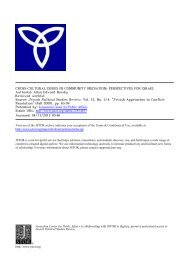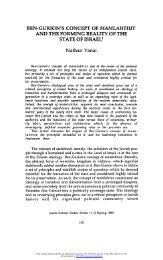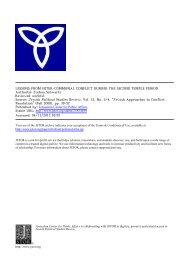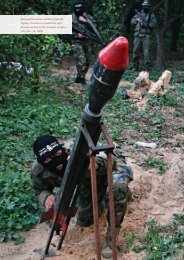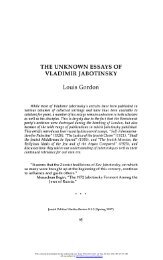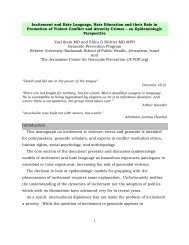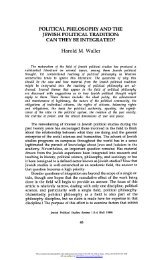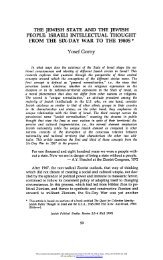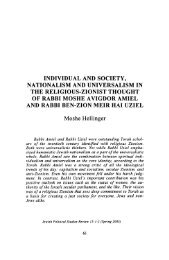the jewish community of cuba: between continuity and extinction
the jewish community of cuba: between continuity and extinction
the jewish community of cuba: between continuity and extinction
Create successful ePaper yourself
Turn your PDF publications into a flip-book with our unique Google optimized e-Paper software.
120 Margalit Bejaranocircles in defense <strong>of</strong> <strong>the</strong> whole <strong>community</strong>,but were unable to attain <strong>the</strong>confidence <strong>of</strong> <strong>the</strong> dominant group <strong>of</strong> Eastern European Jews. At <strong>the</strong> sametime <strong>the</strong>y failed to collaborate with <strong>the</strong> Joint Distribution Committee,which had taken <strong>the</strong> responsibilityfor <strong>the</strong> Jewish refugees, <strong>and</strong>, as in<strong>the</strong> early 1920s, <strong>the</strong>ir philanthropywas limited to <strong>the</strong> activities <strong>of</strong><strong>the</strong>ir women's charity.With <strong>the</strong> decline <strong>of</strong> its philanthropic requirements,<strong>the</strong> UnitedHebrewCongregationremained a small upper class group, livingsocially apart from <strong>the</strong> rest <strong>of</strong> <strong>the</strong> Jewish population. Althoughit dominated one <strong>of</strong> <strong>the</strong> basic Jewish necessities ? <strong>the</strong> cemetery, <strong>the</strong> Americangroup did not lead <strong>the</strong> Jewish <strong>community</strong> at large.The Sephardi CommunityAno<strong>the</strong>r Jewish group that arrived in Cuba wascomposed<strong>of</strong>Sephardi Jews, mostly from <strong>the</strong> European parts <strong>of</strong> Turkey. Their immigration began with young men, seeking<strong>the</strong>ir fortune or fleeing militaryservice, who had arrived in Cubaprior to World War I, who would bejoined by<strong>the</strong>ir families soon after <strong>the</strong> war. In 1926 <strong>the</strong>ir number wasestimated at around 4,000: 1,500 in Havana <strong>and</strong> <strong>the</strong> rest in <strong>the</strong> countryside.19 Like o<strong>the</strong>r immigrantsfrom <strong>the</strong> Middle East, mostly Syrian <strong>and</strong>Lebanese Christians, Sephardi Jews dispersed throughout <strong>the</strong> isl<strong>and</strong>,making<strong>the</strong>ir livingas peddlersor petty merchants.SpeakingLadino(Judeo-Spanish), <strong>the</strong>y had no difficultyin assimilatinginto <strong>the</strong> language <strong>of</strong> <strong>the</strong> country.The first organization <strong>of</strong> CubanSephardi Jews, <strong>the</strong> Union HebreaChevet Ahim, was founded in 1914 in order to supply all <strong>the</strong> religious<strong>and</strong> social needs <strong>of</strong> <strong>the</strong> Sephardic immigrants. These includeddailyreligious services, kosher meat <strong>and</strong>charity. Burial groundsweregranted by <strong>the</strong> American Jews. Tourists in today'sHavana can visit <strong>the</strong>original building<strong>of</strong> Chevet Ahim, datingfrom <strong>the</strong> early 1920s, locatedon Inquisidor Street, in <strong>the</strong> quarter <strong>of</strong> Old Havana where new immigrants used to settle.The second center <strong>of</strong> Sephardi social life in Havana, <strong>the</strong> club <strong>of</strong> <strong>the</strong>Union Hebrea Chevet Ahim on <strong>the</strong> Avenida del Prado, hastotallydisappeared.The club, which had served as a second synagogue, usedto hold social <strong>and</strong> cultural activities <strong>and</strong>, from <strong>the</strong> 1930s to <strong>the</strong>Revolution, was consideredby Sephardi parents as <strong>the</strong> best place for<strong>the</strong>ir children to find a Jewish spouse.Chevet Ahim was considered <strong>the</strong> mo<strong>the</strong>r-<strong>community</strong> <strong>of</strong> Sephardiorganizationsin <strong>the</strong> interior, most <strong>of</strong> which were founded in <strong>the</strong> 1920s,<strong>and</strong> it maintained contact with <strong>the</strong>m through<strong>the</strong> yearly supply<strong>of</strong>matzot or joint fundraising campaigns. The two major communities outside Havana were in Camaguey<strong>and</strong> Santiagode Cuba; both had aThis content downloaded by <strong>the</strong> authorized user from 192.168.72.230 on Sun, 2 Dec 2012 04:14:50 AMAll use subject to JSTOR Terms <strong>and</strong> Conditions



